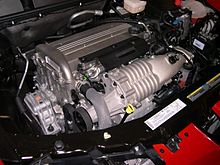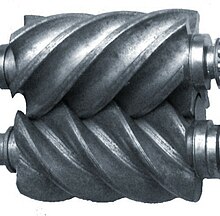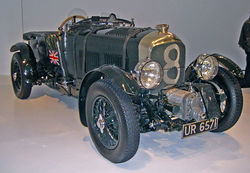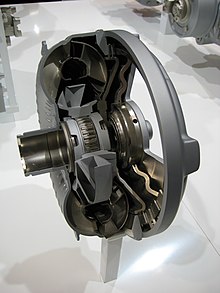Camshaft:~
Camshaft by Rishabh Sharma on Scribd
A camshaft is a shaft to which a cam is fastened or of which a cam forms an integral part.
Among the first cars to utilize engines with single overhead camshafts were the Maudslay designed by Alexander Craig and introduced in 1902 and the Marr Auto Car designed by Michigan native Walter Lorenzo Marr in 1903.
Billet Steel: When a high quality camshaft or low volume production is required, engine builders and camshaft manufacturers choose steel billet. This is a much more time consuming process, and is generally more expensive than other methods. However the finished product is far superior. CNC lathes, CNC milling machines and CNC camshaft grinders will be used during production. Different types of steel bar can be used, one example being EN40b. When manufacturing a camshaft from EN40b, the camshaft will also be heat treated via gas nitriding, which changes the micro-structure of the material. It gives a surface hardness of 55-60 HRC. These types of camshafts can be used in high-performance engines.
The relationship between the rotation of the camshaft and the rotation of the crankshaft is of critical importance. Since the valves control the flow of the air/fuel mixture intake and exhaust gases, they must be opened and closed at the appropriate time during the stroke of the piston. For this reason, the camshaft is connected to the crankshaft either directly, via a gear mechanism, or indirectly via a belt or chain called a timing belt or timing chain. Direct drive using gears is unusual because of the cost. The frequently reversing torque caused by the slope of the cams tends to cause gear rattle which for an all-metal gear train requires further expense of a cam damper. Rolls-Royce V8 (1954) used gear drive as unlike chain it could be made silent and to last the life of the engine. Where gears are used in cheaper cars, they tend to be made from resilient fibre rather than metal, except in racing engines that have a high maintenance routine. Fibre gears have a short life span and must be replaced regularly, much like a timing belt. In some designs the camshaft also drives the distributor and the oil and fuel pumps. Some vehicles may have the power steering pump driven by the camshaft. With some early fuel injection systems, cams on the camshaft would operate the fuel injectors. Honda redesigned the VF750 from chain drive to gear drive VFR750 due to insurmountable problems with the VF750 Hi-Vo inverted chain drive.
An alternative used in the early days of OHC engines was to drive the camshaft(s) via a vertical shaft with bevel gears at each end. This system was, for example, used on the pre-WW1 Peugeot and Mercedes Grand Prix cars. Another option was to use a triple eccentric with connecting rods; these were used on certain W.O. Bentley-designed engines and also on the Leyland Eight.
In a two-stroke engine that uses a camshaft, each valve is opened once for every rotation of the crankshaft; in these engines, the camshaft rotates at the same speed as the crankshaft. In a four-stroke engine, the valves are opened only half as often; thus, two full rotations of the crankshaft occur for each rotation of the camshaft.
The timing of the camshaft can be advanced to produce better low RPM torque, or retarded for better high RPM power. Either of these moves the overall power produced by the engine down or up the RPM scale respectively. The amount of change is very little (usually < 5 deg), and affects valve to piston clearances.
Duration can often be confusing because manufacturers may select any lift point to advertise a camshaft's duration and sometimes will manipulate these numbers. The power and idle characteristics of a camshaft rated at .006" will be much different than one rated the same at .002".
Many performance engine builders gauge a race profile's aggressiveness by looking at the duration at .020", .050" and .200". The .020" number determines how responsive the motor will be and how much low end torque the motor will make. The .050" number is used to estimate where peak power will occur, and the .200" number gives an estimate of the power potential.
A secondary effect of increased duration is increasing overlap, which is the number of crankshaft degrees during which both intake and exhaust valves are off their seats. It is overlap which most affects idle quality, inasmuch as the "blow-through" of the intake charge which occurs during overlap reduces engine efficiency, and is greatest during low RPM operation. In reality, increasing a camshaft's duration typically increases the overlap event, unless one spreads lobe centers between intake and exhaust valve lobe profiles.
Higher lift allows accurate timing of airflow; although even by allowing a larger volume of air to pass in the relatively larger opening, the brevity of the typical duration with a higher lift cam results in less airflow than with a cam with lower lift but more duration, all else being equal. On forced induction motors this higher lift could yield better results than longer duration, particularly on the intake side. Notably though, higher lift has more potential problems than increased duration, in particular as valve train rpm rises which can result in more inefficient running or loss of torque.
Cams that have too high a resultant valve lift, and at high rpm, can result in what is called "valve bounce", where the valve spring tension is insufficient to keep the valve following the cam at its apex. This could also be as a result of a very steep rise of the lobe and short duration, where the valve is effectively shot off the end of the cam rather than have the valve follow the cams’ profile. This is typically what happens on a motor over rev. This is an occasion where the engine rpm exceeds the engine maximum design speed. The valve train is typically the limiting factor in determining the maximum rpm the engine can maintain either for a prolonged period or temporarily. Sometimes an over rev can cause engine failure where the valve stems become bent as a result of colliding with the piston crowns.
More unusual is the modern W engine (also known as a 'VV' engine to distinguish itself from the pre-war W engines) that has four cylinder banks arranged in a "W" pattern with two pairs narrowly arranged with a 15-degree separation. Even when there are four cylinder banks (that would normally require a total of eight individual camshafts), the narrow-angle design allows the use of just four camshafts in total. For the Bugatti Veyron, which has a 16-cylinder W engine configuration, all the four camshafts are driving a total of 64 valves.
The overhead camshaft design adds more valvetrain components that ultimately incur in more complexity and higher manufacturing costs, but this is easily offset by many advantages over the older OHV design: multi-valve design, higher RPM limit and design freedom to better place valves, ignition (Spark-ignition engine) and intake/exhaust ports.
Sliding friction between the surface of the cam and the cam follower which rides upon it is considerable. In order to reduce wear at this point, the cam and follower are both surface hardened, and modern lubricant motor oils contain additives specifically to reduce sliding friction. The lobes of the camshaft are usually slightly tapered, causing the cam followers or valve lifters to rotate slightly with each depression, and helping to distribute wear on the parts. The surfaces of the cam and follower are designed to "wear in" together, and therefore when either is replaced, the other should be as well to prevent excessive rapid wear. In some engines, the flat contact surfaces are replaced with rollers, which eliminate the sliding friction and wear but adds mass to the valvetrain.
However, OHC camshaft bearings do not always have replaceable bearing shells, meaning that a new cylinder head is required if the bearings suffer wear due to insufficient or dirty oil.
History:~
An early cam was built into Hellenistic water-driven automata from the 3rd century BC. The camshaft was later described in Turkey (Diyarbakır) by Al-Jazari in 1206. He employed it as part of his automata, water-raising machines, and water clocks such as the castle clock. The cam and camshaft later appeared in European mechanisms from at least the 14th century, or possibly earlier.Among the first cars to utilize engines with single overhead camshafts were the Maudslay designed by Alexander Craig and introduced in 1902 and the Marr Auto Car designed by Michigan native Walter Lorenzo Marr in 1903.
Uses:~
In internal combustion engines with pistons, the camshaft is used to operate poppet valves. It then consists of a cylindrical rod running the length of the cylinder bank with a number of oblong lobes protruding from it, one for each valve. The cam lobes force the valves open by pressing on the valve, or on some intermediate mechanism as they rotate.Automotive:~
Materials
Camshafts can be made out of several types of material. These include:
Chilled iron castings: Commonly used in high volume production, chilled iron camshafts have a good wear resistance since the chilling process hardens them. Other elements are added to the iron before casting to make the material more suitable for its application.Billet Steel: When a high quality camshaft or low volume production is required, engine builders and camshaft manufacturers choose steel billet. This is a much more time consuming process, and is generally more expensive than other methods. However the finished product is far superior. CNC lathes, CNC milling machines and CNC camshaft grinders will be used during production. Different types of steel bar can be used, one example being EN40b. When manufacturing a camshaft from EN40b, the camshaft will also be heat treated via gas nitriding, which changes the micro-structure of the material. It gives a surface hardness of 55-60 HRC. These types of camshafts can be used in high-performance engines.
Timing
 |
A steel billet racing camshaft with noticeably broad lobes (very long duration) |
An alternative used in the early days of OHC engines was to drive the camshaft(s) via a vertical shaft with bevel gears at each end. This system was, for example, used on the pre-WW1 Peugeot and Mercedes Grand Prix cars. Another option was to use a triple eccentric with connecting rods; these were used on certain W.O. Bentley-designed engines and also on the Leyland Eight.
In a two-stroke engine that uses a camshaft, each valve is opened once for every rotation of the crankshaft; in these engines, the camshaft rotates at the same speed as the crankshaft. In a four-stroke engine, the valves are opened only half as often; thus, two full rotations of the crankshaft occur for each rotation of the camshaft.
The timing of the camshaft can be advanced to produce better low RPM torque, or retarded for better high RPM power. Either of these moves the overall power produced by the engine down or up the RPM scale respectively. The amount of change is very little (usually < 5 deg), and affects valve to piston clearances.
Duration
Duration is the number of crankshaft degrees of engine rotation during which the valve is off the seat. As a generality, greater duration results in more horsepower. The RPM at which peak horsepower occurs is typically increased as duration increases at the expense of lower rpm efficiency (torque).Duration can often be confusing because manufacturers may select any lift point to advertise a camshaft's duration and sometimes will manipulate these numbers. The power and idle characteristics of a camshaft rated at .006" will be much different than one rated the same at .002".
Many performance engine builders gauge a race profile's aggressiveness by looking at the duration at .020", .050" and .200". The .020" number determines how responsive the motor will be and how much low end torque the motor will make. The .050" number is used to estimate where peak power will occur, and the .200" number gives an estimate of the power potential.
A secondary effect of increased duration is increasing overlap, which is the number of crankshaft degrees during which both intake and exhaust valves are off their seats. It is overlap which most affects idle quality, inasmuch as the "blow-through" of the intake charge which occurs during overlap reduces engine efficiency, and is greatest during low RPM operation. In reality, increasing a camshaft's duration typically increases the overlap event, unless one spreads lobe centers between intake and exhaust valve lobe profiles.
Lift
The camshaft "lift" is the resultant net rise of the valve from its seat. The further the valve rises from its seat the more airflow can be released, which is generally more beneficial. Greater lift has some limitations. Firstly, the lift is limited by the increased proximity of the valve head to the piston crown and secondly greater effort is required to move the valve's springs to higher state of compression. Increased lift can also be limited by lobe clearance in the cylinder head construction, so higher lobes may not necessarily clear the framework of the cylinder head casing. Higher valve lift can have the same effect as increased duration where valve overlap is less desirable.Higher lift allows accurate timing of airflow; although even by allowing a larger volume of air to pass in the relatively larger opening, the brevity of the typical duration with a higher lift cam results in less airflow than with a cam with lower lift but more duration, all else being equal. On forced induction motors this higher lift could yield better results than longer duration, particularly on the intake side. Notably though, higher lift has more potential problems than increased duration, in particular as valve train rpm rises which can result in more inefficient running or loss of torque.
Cams that have too high a resultant valve lift, and at high rpm, can result in what is called "valve bounce", where the valve spring tension is insufficient to keep the valve following the cam at its apex. This could also be as a result of a very steep rise of the lobe and short duration, where the valve is effectively shot off the end of the cam rather than have the valve follow the cams’ profile. This is typically what happens on a motor over rev. This is an occasion where the engine rpm exceeds the engine maximum design speed. The valve train is typically the limiting factor in determining the maximum rpm the engine can maintain either for a prolonged period or temporarily. Sometimes an over rev can cause engine failure where the valve stems become bent as a result of colliding with the piston crowns.
Position
Depending on the location of the camshaft, the cams operate the valves either directly or through a linkage of pushrods and rockers. Direct operation involves a simpler mechanism and leads to fewer failures, but requires the camshaft to be positioned at the top of the cylinders. In the past when engines were not as reliable as today this was seen as too much bother, but in modern gasoline engines the overhead cam system, where the camshaft is on top of the cylinder head, is quite common.Number of camshafts:~
While today some cheaper engines rely on a single camshaft per cylinder bank, which is known as a single overhead camshaft (SOHC), most modern engine designs (the overhead-valve or OHV engine being largely obsolete on passenger vehicles), are driven by a two camshafts per cylinder bank arrangement (one camshaft for the intake valves and another for the exhaust valves); such camshaft arrangement is known as a double or dual overhead cam (DOHC), thus, a V engine, which has two separate cylinder banks, may have four camshafts (colloquially known as a quad-cam engine).More unusual is the modern W engine (also known as a 'VV' engine to distinguish itself from the pre-war W engines) that has four cylinder banks arranged in a "W" pattern with two pairs narrowly arranged with a 15-degree separation. Even when there are four cylinder banks (that would normally require a total of eight individual camshafts), the narrow-angle design allows the use of just four camshafts in total. For the Bugatti Veyron, which has a 16-cylinder W engine configuration, all the four camshafts are driving a total of 64 valves.
The overhead camshaft design adds more valvetrain components that ultimately incur in more complexity and higher manufacturing costs, but this is easily offset by many advantages over the older OHV design: multi-valve design, higher RPM limit and design freedom to better place valves, ignition (Spark-ignition engine) and intake/exhaust ports.
Maintenance:~
The rockers or cam followers sometimes incorporate a mechanism to adjust and set the valve play through manual adjustment, but most modern auto engines have hydraulic lifters, eliminating the need to adjust the valve lash at regular intervals as the valvetrain wears, and in particular the valves and valve seats in the combustion chamber.Sliding friction between the surface of the cam and the cam follower which rides upon it is considerable. In order to reduce wear at this point, the cam and follower are both surface hardened, and modern lubricant motor oils contain additives specifically to reduce sliding friction. The lobes of the camshaft are usually slightly tapered, causing the cam followers or valve lifters to rotate slightly with each depression, and helping to distribute wear on the parts. The surfaces of the cam and follower are designed to "wear in" together, and therefore when either is replaced, the other should be as well to prevent excessive rapid wear. In some engines, the flat contact surfaces are replaced with rollers, which eliminate the sliding friction and wear but adds mass to the valvetrain.
Camshaft bearings are similar to crankshaft main bearings, being pressure-fed with oil.
However, OHC camshaft bearings do not always have replaceable bearing shells, meaning that a new cylinder head is required if the bearings suffer wear due to insufficient or dirty oil.
Alternatives
In addition to mechanical friction, considerable force is required to overcome the valve springs used to close the engine's valves. This can amount to an estimated 25% of an engine's total output at idle, reducing overall efficiency. Some approaches to reclaiming this "wasted" energy include:- Springless valves, like the desmodromic system employed today by Ducati
- Camless valvetrains using solenoids or magnetic systems have long been investigated by BMW and Fiat, and are currently being prototyped by Valeo and Ricardo
- The Wankel engine, a rotary engine which uses neither pistons nor valves, best known for being used by Mazda in the RX-7 and RX-8 sports cars.
- Koenigsegg has developed an electric valve actuator as a more fuel efficient and space saving alternative to the traditional camshaft.








 = ambient air temperature
= ambient air temperature = temperature after the compressor
= temperature after the compressor = ambient atmospheric pressure (absolute)
= ambient atmospheric pressure (absolute) = pressure after the compressor (absolute)
= pressure after the compressor (absolute) = Ratio of specific heat capacities =
= Ratio of specific heat capacities =  = 1.4 for air
= 1.4 for air = Specific heat at constant pressure
= Specific heat at constant pressure = Specific heat at constant volume
= Specific heat at constant volume
















 , where
, where  is the mass density of the fluid (kg/m³),
is the mass density of the fluid (kg/m³),  is the impeller speed (rpm), and
is the impeller speed (rpm), and  is the diameter(m).In practice, the maximum torque capacity is limited by the mechanical characteristics of the materials used in the converter's components, as well as the ability of the converter to dissipate heat (often through water cooling). As an aid to strength, reliability and economy of production, most automotive converter housings are of welded construction. Industrial units are usually assembled with bolted housings, a design feature that eases the process of inspection and repair, but adds to the cost of producing the converter.
is the diameter(m).In practice, the maximum torque capacity is limited by the mechanical characteristics of the materials used in the converter's components, as well as the ability of the converter to dissipate heat (often through water cooling). As an aid to strength, reliability and economy of production, most automotive converter housings are of welded construction. Industrial units are usually assembled with bolted housings, a design feature that eases the process of inspection and repair, but adds to the cost of producing the converter.

